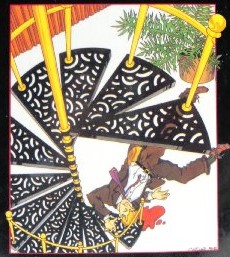Slowly but surely, my favourite fictional detective is creeping into the public domain. At least in the US. I’d really love to see him brought to the big screen, or even an increased awareness of the fine Edward Petherbridge rendition. Genuinely I could see Benedict Cumberbatch as Bunter, Peter’s manservant, though I’m not sure who I see as Peter. At any rate, there’s only been one version of Murder Must Advertise, and—like all the versions Ian Charmichael made—the writing misses a lot of what gives the story its charm and wit.
One day, a well-dressed man of early middle age comes to work for Pym’s Publicity. He turns out to have the alarming name of Death Bredon. He says it usually rhymes with “teeth,” but he prefers to pronounce it to rhyme with “breath.” He has come to take the place of Victor Dean, a junior copywriter who was killed in a fall down the iron spiral staircase that runs between the two floors the agency takes up in their building. It’s quickly clear that Bredon is aware of more than he says, as he starts rummaging through Dean’s desk for clues.
Meanwhile, at night, he makes the acquaintance of the wealthy and dissipated Dian de Momerie. He’s brought to one of her parties by Pamela Dean, Victor Dean’s sister, and catches Dian’s attention while dressed as a harlequin. In her cocaine-fueled haze, she quickly becomes obsessed with him. Bredon presents himself to her as something of a mystic figure, and he quickly tries to get to know more about the cocaine trafficking. He learns that there’s a connection with Pym’s, but no one seems to quite know what it is.
Now, we as an audience know that Bredon is not who he says he is, and not just because there’s no reason to follow him in a Lord Peter Wimsey novel if he is. For one thing, fans of the series are aware that Peter’s full name is Peter Death Bredon Wimsey. As he says at one point, he is all he says he is, but he does not claim all that he is. We also get some of Peter’s own life, including an occasional charming domestic scene with his sister, Lady Mary, and brother-in-law Chief Inspector Charles Parker. Mostly, though, we are seeing Bredon and Bredon-as-Harlequin.
Dorothy L. Sayers was apparently not terribly fond of this book herself, but it’s long been one of my favourites. She says one of the problems with it is that she knew advertising—she wrote the “Guinness is good for you” jingle, just for starters—but didn’t know the party world of ’20s Bright Young Things. (Or early ’30s. It basically doesn’t matter; the real world doesn’t touch on this story.) It’s true that Dian’s world is one of glittering artificiality, one that never feels fully real. On the other hand, it isn’t real, so who cares? Not in the sense that the story is fiction but in the sense that, within the book, none of these people are their real selves. Bredon’s just one more fake.
And, of course, the advertising agency is as real as it can be while also being transparently artificial as well. This world, Sayers knew. She was a copywriter herself until two years before the novel came out, and the world she creates is vivid. It’s full of well-educated people who have to be careful not to appear too smart. On the other hand, being in advertising feels in some ways more fun than any of the other offices portrayed in the books, so there’s that, I guess. Still, she also makes it clear that the job isn’t all demonstrating cricket terms in the hallway.
Which does bring us to the Cricket Chapter. Pym’s Publicity has a traditional annual cricket match opposite the team from Brotherhood, Ltd., one of the firm’s clients. The getting together of the team has a lot to do with the internal drama of Pym’s, and it lets us get to know a fair bit about the characters, several of whom are suspects in Victor Dean’s death—would Peter be there if he didn’t think it was a murder? But there is a chapter which gives us exhaustive detail about the actual goings-on of the cricket match in question. Think the Quidditch chapters in the Harry Potter books.
The thing is, though, the rules of Quidditch are deliberately intended to be confusing. I can’t imagine anyone set out to make cricket bewildering. However, I’ve read the chapter any number of times and still don’t understand the rules. Obviously Peter is very good at cricket. Obviously he is known for it as Peter and shouldn’t show quite so much skill as Bredon. I get that. I just have no idea why he’s doing anything he’s doing.
There is explicit parallel drawn between the cocaine that fuels Dian and her circle and Nutrax for Nerves, the client that fuels quite a lot of what happens at Pym’s. I’ll admit that, as I don’t know the rules of cricket, I don’t know the laws of over-the-counter medication in the UK at the time. I don’t know if Nutrax was something legal in the US. We never know exactly what Nutrax is, just that it’s a big, important campaign for Pym’s. But it’s strongly implied that it’s something pretty well worthless that is being sold to a British public by the pushers at Pym’s.
I don’t know that this is the best introduction to the world of Lord Peter Wimsey. Logically, you should probably start with Whose Body? However, while it may not have been the book she intended to write—that’s my other favourite non-Harriet book, The Nine Tailors—it’s an interesting dive into a world that shapes our lives even though we generally know very little about it. Certainly we know an awful lot less about it than Sayers did.
Time for my commercial announcement—consider supporting my Patreon or Ko-fi!


